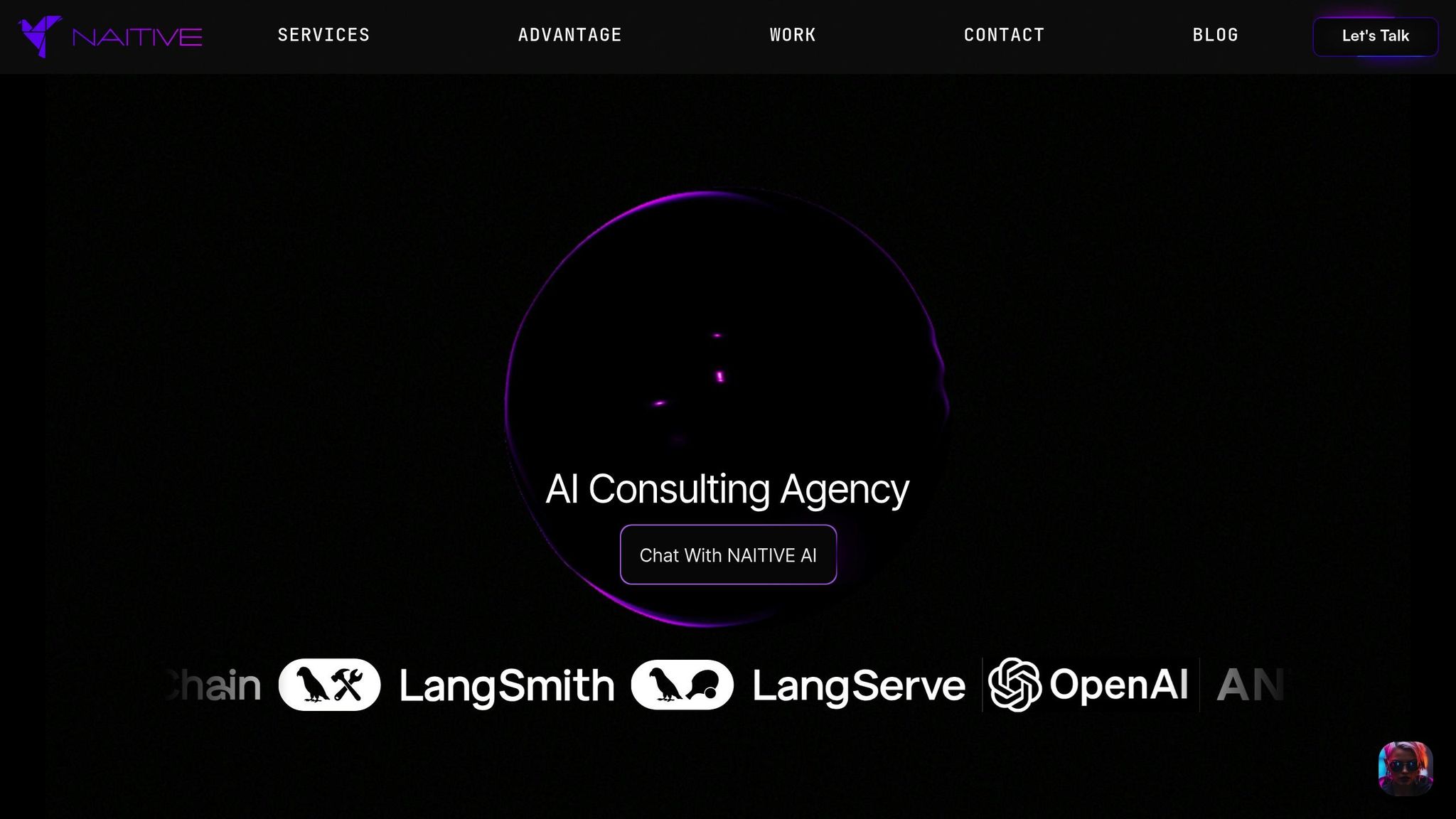Ultimate Guide to AI Cost Allocation Models
Explore effective AI cost allocation models to enhance financial transparency and align spending with business goals, ensuring compliance and resource optimization.

AI cost allocation is the process of distributing expenses from AI projects to relevant departments or cost centers. This ensures transparency in tracking costs like infrastructure, development, and maintenance while aligning them with business goals. U.S. enterprises, in particular, benefit from accurate allocation models due to financial accountability, compliance with GAAP, and improved resource management.
Key Takeaways:
- Why It Matters: Tracks ROI, supports budgeting, and ensures compliance with U.S. accounting standards.
- Core Costs: Includes cloud computing, storage, personnel, model training, and compliance expenses.
- Allocation Models:
- Usage-Based: Costs tied to resource consumption like compute power or data volume.
- Fixed: Predetermined shares for departments, offering budget predictability.
- Hybrid/Outcome-Based: Combines fixed and usage-based elements, aligning costs with results.
- Best Practices: Use clear tracking systems, align costs with business goals, and review allocation models regularly.
Choosing the right model depends on factors like organizational maturity, AI usage patterns, and compliance requirements. Start simple and evolve as your AI operations grow.
Core Components of AI Costs
Key Cost Drivers in AI Projects
Understanding where the money goes in AI projects is critical for effective budgeting. Unlike traditional expenses, AI-related costs can vary - some increase with usage, while others stay steady no matter how much the system is used.
One of the largest expenses in AI projects is infrastructure. This includes cloud computing resources like GPUs and specialized AI chips, which are typically priced based on performance and usage. Storage is another big factor. High-speed storage is needed for active workloads, while more affordable options work for archiving older data.
Model development is another major expense. Building and refining AI systems requires a team of experts - data scientists, machine learning engineers, and AI researchers - who command high salaries due to their specialized skills. Training large models, especially for advanced tasks like natural language processing or computer vision, can also be a major financial undertaking.
Once AI models are deployed, inference and operational costs kick in. These costs often scale with how much the system is used, which means they can spike during periods of high demand. Managing these fluctuations requires careful monitoring and flexible cost strategies.
Data management and preparation also take up a significant portion of both time and money. Tasks like cleaning, labeling, validating, and monitoring data quality are labor-intensive. Many organizations also spend on third-party data services or hire specialized data engineers for these tasks.
Compliance and governance costs are becoming increasingly important as AI regulations evolve. Companies must budget for activities like model auditing, bias testing, documentation, and legal reviews, especially in highly regulated industries such as healthcare and finance.
U.S. Accounting Standards and Cost Center Mapping
Once the cost drivers are identified, aligning them with U.S. accounting standards is a key step. GAAP rules present unique challenges for AI projects compared to traditional software. For example, AI development costs must be sorted into two categories: research and development expenses, which are expensed immediately, and software development costs, which can be capitalized and amortized over time.
Under ASC 350-40, certain costs can be capitalized once the AI project reaches "technological feasibility" and moves into production. However, ongoing operational costs - like cloud computing, data storage, and maintenance - are considered variable expenses. These require detailed tracking, and many organizations create specific general ledger (GL) codes to improve visibility and control.
Cost center mapping can get tricky when AI systems benefit multiple departments. For instance, an AI tool for fraud detection might support risk management, customer service, and compliance teams at the same time. Traditional cost structures often struggle to handle such cross-functional benefits, prompting the need for new allocation methods.
Another challenge involves classifying AI models and datasets as assets. Unlike traditional software or hardware with clear depreciation schedules, AI models can become outdated quickly or need frequent retraining. This makes it harder to treat them as long-term capital assets.
Tracking AI Costs Across Departments
After defining cost categories and aligning them with accounting rules, tracking these expenses across departments becomes essential. Chargeback systems are often used to assign AI costs to the departments that benefit from them. However, AI systems can experience unexpected surges in demand or be used in ways that differ from initial projections. This variability calls for flexible allocation methods.
Usage-based tracking is one approach. It involves monitoring AI interactions, resource consumption, and the resulting business outcomes. Modern cloud platforms offer detailed usage data, but translating this technical information into meaningful metrics for business planning takes careful coordination.
For AI systems that serve multiple departments, cross-departmental allocation is crucial. For example, a predictive analytics platform might help sales teams identify leads, assist marketing teams in optimizing campaigns, and enable finance teams to forecast revenue. Simple cost-splitting methods often fall short in capturing the full scope of benefits.
A more precise method is activity-based costing, which ties AI expenses directly to specific business activities and outcomes. While this approach is more complex to implement, it provides a clearer picture of how AI systems deliver value.
Another option is the shared service model, where AI capabilities are treated as internal services available on demand. This involves setting up internal pricing structures, service level agreements, and detailed usage monitoring systems. A dedicated IT team or an AI center of excellence typically manages these shared resources and oversees cost allocation.
Finally, integrating AI cost tracking with overall budget planning ensures consistency with annual budgets and department goals. This involves forecasting AI usage growth, planning for new applications, and building flexibility into budgets to handle variable costs. Many organizations create centralized AI cost pools that multiple departments can access as needed, streamlining the process and ensuring efficient resource use.
How to allocate LLM costs & track usage of models on Amazon Bedrock and Sagemaker Studio
Types of AI Cost Allocation Models
Organizations use different approaches to allocate AI costs, and the choice often depends on factors like how their teams are structured, how advanced their AI systems are, and the specific ways AI is being used. Below, we break down three main models for AI cost allocation, along with their pros and cons.
Usage-Based Allocation
This model ties costs directly to how much a department uses AI resources, such as compute power, API calls, or data processing. It’s a straightforward way to link resource consumption to expenses, encouraging teams to manage their usage carefully.
- Compute-based allocation: Costs are calculated based on metrics like GPU hours, CPU usage, or memory consumption. For example, if the marketing team uses 40% of the GPU hours, they’ll be charged 40% of the associated costs. This is ideal for organizations with clear usage patterns and good tracking systems in place.
- Transaction-based allocation: Instead of raw computing resources, this focuses on the number of AI interactions. For instance, the customer service team might be charged based on chatbot conversations, while sales could be billed for API calls used in lead scoring. This method aligns costs more closely with business outcomes.
- Data volume allocation: Here, costs are distributed based on the amount of data processed, stored, or analyzed. For example, a fraud detection system might allocate costs by the number of transactions analyzed, while a supply chain tool might charge based on inventory records processed.
The biggest advantage of usage-based allocation is that it’s directly tied to usage, making it easy to see who’s responsible for what. However, it requires detailed tracking systems and can lead to unpredictable budgets. This approach works well for organizations with fluctuating AI usage across departments or those looking to promote efficient resource use.
Fixed Allocation
Fixed allocation takes a different approach by setting predetermined cost shares for each department, regardless of how much they actually use AI. This makes budgeting easier and more predictable, which is particularly helpful for organizations with stable AI usage or limited tracking capabilities.
- Percentage-based fixed allocation: Costs are split based on pre-decided ratios. For instance, sales might cover 50%, marketing 30%, and customer service 20% of the AI budget. These percentages are often based on expected usage or strategic priorities.
- Headcount-based allocation: Costs are divided according to the size of each department. Larger teams are assumed to use more AI resources, so they pay more. While simple, this method might not reflect actual usage accurately.
- Revenue-based allocation: Departments are charged based on their revenue contributions. High-revenue teams pay more, assuming they benefit more from AI and have a greater capacity to cover costs.
The main draw of fixed allocation is its predictability. Finance teams can plan months ahead, which is especially useful for companies with seasonal fluctuations or tight budget controls. However, this model can lead to inefficiencies, as departments with low AI usage might end up subsidizing heavier users. It’s a good fit for early-stage AI implementations or when tracking costs is too expensive to justify.
Hybrid and Outcome-Based Models
For organizations looking for a balance between fairness and predictability, hybrid and outcome-based models offer more nuanced approaches. These methods combine elements of both usage-based and fixed allocation, tailoring costs to reflect both consumption and business results.
- Base-plus-usage hybrids: Each department pays a fixed base fee for access to AI systems, with additional charges for usage beyond a certain threshold. For example, teams might pay a $10,000 monthly fee plus extra for exceeding pre-set compute hours.
- Tiered allocation models: Departments are grouped into tiers based on their usage levels. Light users pay a flat fee, moderate users are charged based on usage, and heavy users might get discounts for high volumes.
- Outcome-based allocation: Here, costs are tied to measurable business outcomes rather than resource usage. For example, the sales team might pay based on the extra revenue generated by AI-driven lead scoring, while manufacturing might be billed for cost savings achieved with predictive maintenance.
- Performance-based allocation: Costs are adjusted based on how well AI systems perform for different departments. If a system delivers better results for one team, they might pay more, incentivizing collaboration to improve AI performance.
These models are great for aligning costs with business value, but they require detailed tracking and robust performance metrics. They’re typically adopted by organizations with mature AI operations and clear ways to measure success. Many companies start with simpler fixed or usage-based models and gradually transition to hybrid approaches as their AI systems and tracking capabilities evolve.
Comparing AI Cost Allocation Models
This section dives into the strengths and challenges of different AI cost allocation models, helping you choose the one that best suits your needs. The model you pick can significantly shape your AI strategy, affecting budget planning, accountability, and how smoothly AI is adopted across your organization.
Comparison Table of Allocation Models
The table below highlights how the three main allocation models differ in terms of complexity, cost predictability, and alignment with actual usage. Each model offers unique advantages and trade-offs.
| Factor | Usage-Based | Fixed Allocation | Hybrid/Outcome-Based |
|---|---|---|---|
| Transparency | High - costs directly tied to usage | Low - may not reflect actual consumption | Medium - blends usage visibility with fixed components |
| Budget Predictability | Low - fluctuates with usage | High - fixed monthly or quarterly amounts | Medium - base costs are fixed, variable elements add some uncertainty |
| Implementation Complexity | High - requires real-time tracking and monitoring | Low - simple percentage or headcount-based calculations | High - needs performance tracking and detailed metrics |
| Fairness | High - departments pay based on usage | Low - light users may subsidize heavy users | High - balances usage with business impact |
| Scalability | Medium - tracking becomes harder as usage grows | High - easy to scale without extra overhead | Low - needs continuous updates to metrics and thresholds |
| Alignment with Business Goals | Medium - encourages efficiency but may limit experimentation | Low - disconnects costs from AI value | High - ties costs to measurable outcomes |
| U.S. Compliance Readiness | High - detailed tracking supports GAAP requirements | Medium - simpler but less justification detail | High - outcome tracking aids ROI documentation |
This comparison provides a foundation for matching a model to your operational goals.
Key Factors for Model Selection
When deciding on an allocation model, several factors come into play, each shaping how well the model fits your organization.
Organizational maturity plays a big role. Early adopters often benefit from fixed allocation due to its straightforward budgeting. More experienced organizations, on the other hand, may lean toward usage-based models to encourage responsible resource use.
Industry regulations are especially important for U.S. companies in sectors like healthcare, finance, or defense. Detailed cost tracking is often required to meet compliance standards. For example, the Sarbanes-Oxley Act demands precise cost reporting, making usage-based or hybrid models a better fit for publicly traded companies.
Team structure and culture also matter. Collaborative teams might struggle with usage-based models if they create budget silos. Meanwhile, organizations with a strong accountability culture may thrive with outcome-based models, which reward measurable results.
Technical infrastructure can either enable or limit your options. Usage-based models require robust IT systems capable of real-time tracking. Without such infrastructure, fixed allocation becomes the practical choice.
Financial planning preferences differ across organizations. Those focused on tight cash flow management often prefer fixed allocation for its predictability. Growth-oriented companies, however, may opt for usage-based models to encourage experimentation and innovation. The decision often reflects broader financial strategies and risk tolerance.
Departmental AI usage patterns are another key consideration. If AI use is concentrated in a few departments, usage-based models make sense. For organizations with widespread adoption, fixed allocation may be easier to manage. Seasonal businesses may prefer hybrid models that combine a base fee with usage-based components to handle demand fluctuations.
Long-term strategic goals also influence the decision. Companies aiming for rapid AI expansion need scalable models that won’t require constant overhauls. Those prioritizing AI ROI measurement may find outcome-based models worth the extra setup effort.
Geographic considerations can’t be ignored either. U.S. companies operating across multiple states must navigate varying tax laws and accounting standards. Some states offer AI development incentives that affect cost strategies, while others impose specific reporting requirements, making certain models more practical.
Many organizations start with fixed allocation models and transition to more sophisticated approaches as their AI capabilities mature. This gradual shift allows teams to adapt and build expertise without overloading their systems early on.
Best Practices for AI Cost Allocation
Building on the allocation models outlined earlier, these best practices aim to improve cost tracking and align AI investments with business goals. By implementing these steps, organizations can enhance financial transparency and ensure their AI spending supports strategic objectives.
Setting Up Clear Cost Tracking
To effectively monitor AI-related expenses, it's essential to establish a system that provides real-time visibility into resource usage. Categorize costs based on Generally Accepted Accounting Principles (GAAP) into three main groups:
- Direct costs: These include expenses like compute power, software licenses, and personnel.
- Indirect costs: Shared infrastructure and general overhead fall into this category.
- Capital expenses: Items like hardware purchases and major software investments are included here.
Using cloud-based tools to automate cost tracking simplifies this process. Many platforms offer features that allow you to tag and categorize expenses down to specific machine learning models or business units. This level of detail helps teams manage their budgets more effectively.
Dashboards can further enhance visibility by providing real-time insights. Finance teams can track overall spending, while technical teams can dive into granular usage metrics to identify areas for optimization and cost savings.
Consistency in tagging AI resources is key. Adding project codes, department IDs, and cost center markers ensures accurate cost allocation and simplifies reporting. These foundational practices connect financial data to broader business outcomes.
Aligning Cost Allocation with Business Goals
To make AI spending meaningful, link costs to measurable business metrics like revenue growth or operational savings. This connection helps justify investments and guides future resource allocation.
Clear accountability structures are also critical. For usage-based models, department heads should understand how their teams' AI consumption impacts their budgets. For outcome-based models, set performance targets and measurement criteria upfront to avoid disagreements later.
Timing matters too. Many U.S. companies align cost reviews with quarterly reporting cycles, but some AI projects - especially those in development or with seasonal demand - may require more frequent tracking, such as monthly or weekly reviews.
Encouraging efficient AI usage can also drive better results. While usage-based allocations naturally promote cost awareness, organizations can take it further by rewarding teams that demonstrate high returns on their AI investments. Recognizing efforts like building reusable models or achieving cost reductions through automation can incentivize smart spending.
Lastly, keep tax regulations in mind when structuring your allocation models. Compliance with current policies ensures that your financial strategies remain sound.
Regular Reviews and Optimization
Once tracking systems and alignment with business goals are in place, regular reviews help keep the allocation model relevant and effective. These reviews should assess metrics like cost accuracy, budget variance, and how well the model supports decision-making. Stakeholder feedback is also valuable to ensure satisfaction with the process.
Changes in market conditions, organizational structure, or AI capabilities may require adjustments to your allocation model. Benchmarking against industry standards can provide useful insights, but remember to tailor any approach to your organization's specific needs.
As AI adoption scales, be prepared for challenges. Fixed allocation models might not handle increased complexity, and usage-based models may require infrastructure upgrades to manage tracking demands. Anticipating these hurdles ensures your system remains accurate as your AI initiatives grow.
Documenting lessons learned from allocation changes can benefit the entire organization. Sharing this knowledge helps when introducing AI to new departments or justifying decisions to auditors and stakeholders.
Finally, stay alert to regulatory changes that could impact AI cost reporting. A flexible allocation system is better equipped to adapt to evolving financial reporting and compliance requirements.
NAITIVE AI Consulting Agency specializes in helping organizations implement these best practices. Their expertise spans cost tracking system design, allocation model selection, and ongoing optimization, allowing businesses to avoid pitfalls and establish sound AI cost management strategies.
Before rolling out major changes, pilot testing is essential. Testing allocation adjustments with select departments or projects helps identify potential issues and refine processes, minimizing disruption during full implementation. This approach ensures a smoother transition and greater acceptance among stakeholders.
Conclusion
This guide has highlighted the importance of managing AI costs effectively by exploring key cost drivers and comparing allocation models. Thoughtful AI cost allocation isn't just about keeping expenses in check - it's about laying the groundwork for sustainable AI growth and achieving measurable business results.
Key Takeaways
The best AI cost allocation strategies combine precise tracking systems with goals aligned to business priorities. This approach enhances financial transparency, helping teams fine-tune resource use and make smarter investment decisions. For instance:
- Usage-based models often lead to better resource efficiency.
- Outcome-based models align spending more closely with ROI and business objectives.
Since AI technologies evolve so quickly, regular optimization is crucial. Organizations that review their allocation models quarterly tend to maintain tighter cost control and achieve better results overall.
Compliance is another growing concern in AI cost allocation. As regulations around AI governance and financial reporting continue to change, having a strong allocation framework ensures businesses meet current standards while staying flexible for future requirements.
NAITIVE AI Consulting Agency's Role in AI Cost Allocation

NAITIVE AI Consulting Agency specializes in turning AI cost allocation into a strategic advantage. With deep expertise in AI infrastructure costs, they design allocation models that not only reflect actual resource usage but also align with your unique business goals.
What sets NAITIVE apart is their tailored approach. They don’t rely on generic solutions; instead, they assess your organization’s specific needs, financial workflows, and level of AI maturity. This allows them to create frameworks that integrate seamlessly with your existing processes while preparing you for future growth.
Their emphasis on measurable outcomes ensures cost optimization aligns with broader goals like automating business processes. For companies ready to move beyond basic cost tracking, NAITIVE delivers the expertise needed to implement allocation models that drive meaningful results.
FAQs
How can businesses choose the right AI cost allocation model for their needs?
To choose the most suitable AI cost allocation model, businesses need to weigh their goals, financial limits, and operational strengths. It’s important to look at aspects like how well the model can grow with your needs, how complex it is to implement, and how it fits within your organization’s overall approach and priorities.
In many cases, a hybrid model can be a smart choice. By combining elements from various models, companies can achieve a balance of flexibility and precision across their AI initiatives. Customizing the approach to match your specific needs can help manage expenses effectively while delivering strong performance and value.
What challenges do businesses face when aligning AI cost allocation with U.S. GAAP standards?
Aligning AI cost allocation with U.S. GAAP standards isn't exactly straightforward. Companies often face difficulties in accurately identifying and categorizing expenses tied to R&D, data acquisition, and software development, largely because AI technologies evolve so quickly. This constant state of change adds layers of complexity, making proper cost classification a real challenge.
Another hurdle is the absence of clear, dedicated guidelines for AI-related costs under U.S. GAAP. This lack of direction can create uncertainty, leading to inconsistent accounting practices. Such inconsistencies might result in compliance headaches or even errors in financial reporting. To navigate these challenges, businesses can benefit from staying informed about regulatory updates and consulting with experts in the field.
What are hybrid and outcome-based AI cost allocation models, and how do they ensure fairness and budget predictability?
Hybrid AI cost allocation models aim to strike a balance between equity and predictable budgeting. They allocate costs based on actual usage or the benefits received, ensuring that each department or team contributes in proportion to their consumption. At the same time, these models use predictive analytics to dynamically manage resources, helping to minimize unexpected financial surprises.
In contrast, outcome-based models link expenses directly to the results achieved. This approach aligns spending with the value delivered, offering a performance-driven framework. However, it can introduce cost fluctuations if not carefully monitored. By blending these two approaches, organizations can achieve the stability of hybrid systems while introducing performance-based incentives to encourage fairness and accountability.




